Enjoy this delicious Bavarian-style sauerkraut recipe made with caraway seeds. In this step-by-step recipe, you will learn to make old fashioned sauerkraut with caraway seeds in a mason jar. If you are new to fermentation, this is one of the best and easiest recipes to get you started.
Caraway Seeds in Sauerkraut
When you are looking at Bavarian sauerkraut versus regular sauerkraut, the main difference is flavor. Bavarian sauerkraut is slightly sweeter than regular sauerkraut and it contains caraway seeds.
Bavarian sauerkraut gets its sweetness from serving it with a bit of sugar after it is fermented. Caraway seeds also naturally add an herbaceous sweet flavor.
Anytime I make sauerkraut with caraway seeds and green cabbage I consider it Bavarian style. I consider regular, or plain German sauerkraut recipes, any plain green cabbage sauerkraut made without spices.
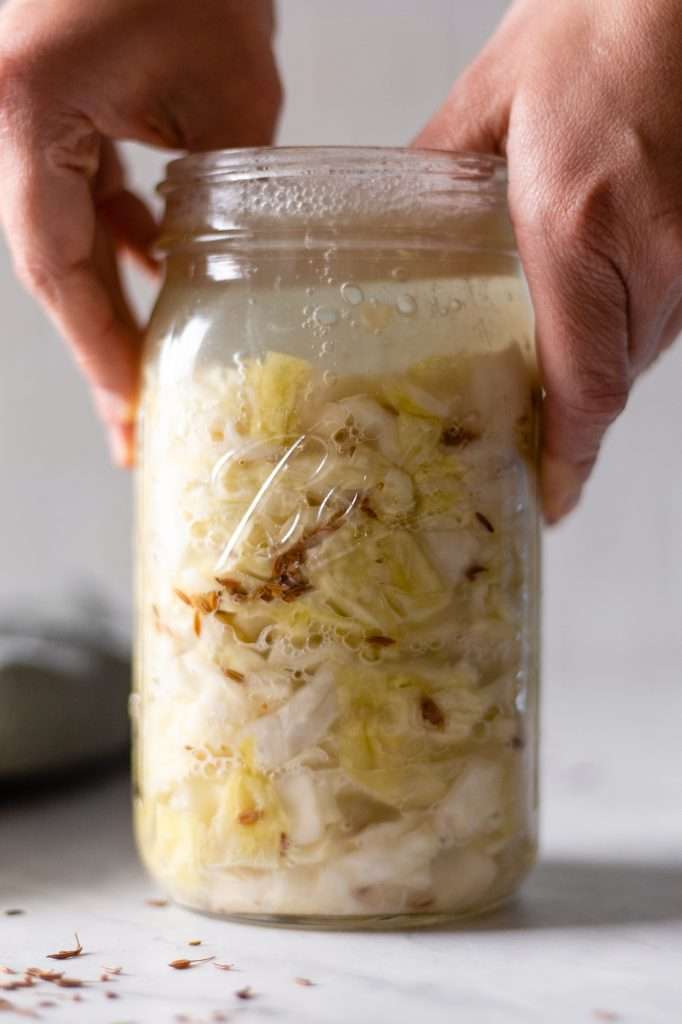
Liberty Cabbage
One of the most interesting stories about sauerkraut comes from World War I. In the 19th century, the United States received about 5 million immigrants from Germany.
Many German-Americans settled in the mid-west to live on farms, build businesses, and become trades professionals. By the early 1900s, Germans were the largest immigrant group in America. They built restaurants, businesses, banks, churches, and entire communities.
Then World War I began, and Germans were intensely scrutinized, subject to prejudice, and cultural erasure. Americans during these times became so anti-German, that they wouldn’t even call German foods by their given names.
Sauerkraut was renamed “Liberty Cabbage”, Hamburgers were called “Liberty Steak”, and frankfurters and bratwurst were dubbed “Liberty Sausage”. People actually believed that renaming German foods was an act of patriotism.
Why did referring to sauerkraut as liberty cabbage seem patriotic? Well, because people during that time thought that being anti-German was patriotic. Alas, liberty cabbage didn’t stick, and we still call fermented cabbage sauerkraut, as it should be.
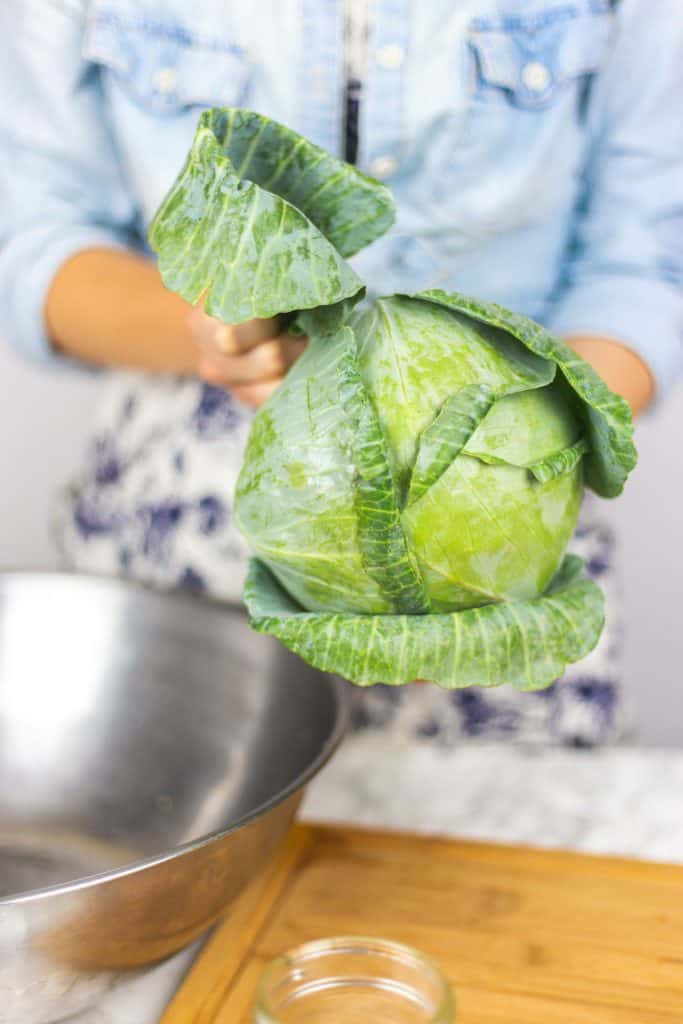


Using Caraway Seeds in Sauerkraut
To make classic caraway sauerkraut, you must add the caraway seeds at the beginning of fermentation. I always add the seeds when I add my salt to the mixing bowl. This allows me to really mix the seeds in with the cabbage to evenly distribute the flavor.
You should always add caraway seeds to sauerkraut before fermentation so the seeds can release and impart more flavor throughout the sauerkraut as it ferments.
You can adjust the amount of caraway seeds you add to the kraut depending on your flavor preference. For a lighter flavor start with just 5 grams per quart.
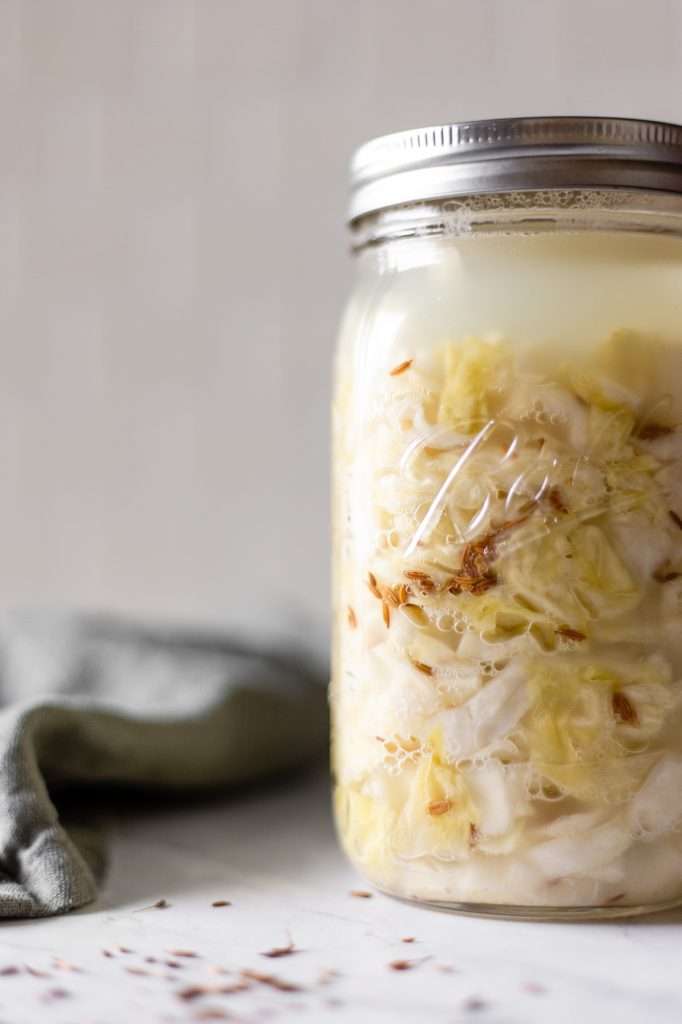
The Best Cabbage for Sauerkraut
The best cabbage for sauerkraut is organic green cabbage. Any green cabbage will do, and you can also use Chinese (napa) cabbage.
If you cannot get organic cabbage, conventional cabbage works perfectly in this recipe too. Since you remove the outermost leaves from cabbage before fermenting, even conventionally grown cabbage is essentially pesticide-free.
How to Make Old Fashioned Sauerkraut
Homemade Sauerkraut is definitely the best type of fermented food to make if you’re new to fermenting vegetables at home. Sauerkraut is particularly easy for a first fermentation project because cabbage ferments extremely well.
The water content along with the microbial species richness of cabbage makes it optimal for wild fermentation!
For old-fashioned sauerkraut flavor and texture, you should use weight measurements for your fermentation ingredients. That means you need a kitchen scale. Weighing your ingredients gives you consistent and superior fermentation results. This is the scale we use in our home kitchen.

Fermenting Jars and Supplies for Making Old Fashioned Sauerkraut with caraway seeds
- 32 ounce Wide Mouth Mason Jar
- Fermentation Weight
- Standard Metal Mason Jar Lid (this can rust in the presence of salt)
- OR Rust Free Plastic Lid
- or you can use a Weck Jar (without the gasket; only use the clips to secure the lid)
- Sea Salt
- Scale
- Mixing Bowl
Old Fashioned Sauerkraut in a Mason Jar
During the first few days of fermentation: carbon dioxide and bubbles will be produced. Sometimes mason jars will become very full of liquid, and this liquid can seep out. You will need to burp the jar.
- When burping the jar, remove the lid and tamper everything back down using a clean tamper or spoon. Make sure everything, including the weight is still submerged below the brine.
Always Trust your sense of smell: In the beginning fermenting cabbage smells funky. When fermentation is finished, fermented cabbage should smell pleasantly sour and like strong cabbage. Never eat anything that smells repulsive or yeasty.
Never eat anything that had mold growing on it: By following directions you should not encounter this problem.
After 3-4 weeks, remove the fermentation weight and smell and taste test. Your fermented cabbage should smell pleasantly sour. It should taste tart, salty and cabbage.
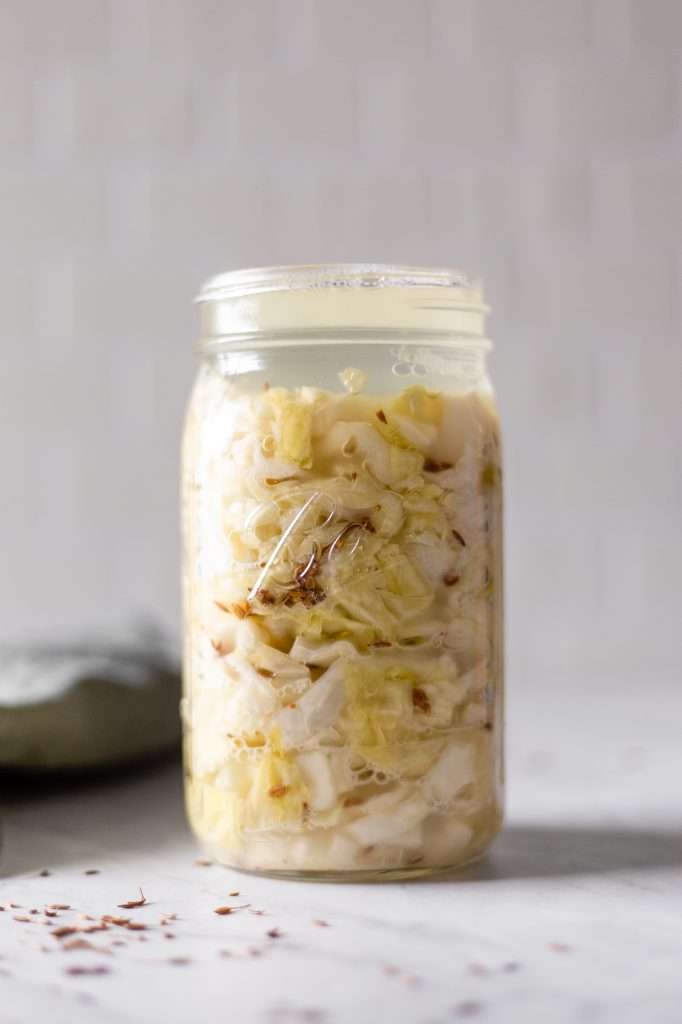
The Best Temperature to Ferment Sauerkraut with Caraway Seeds
Keep your fermenting cabbage at a temperature between 70-80 degrees F for best results, and keep the jar out of direct sunlight. If your fermentation temperatures are warmer and closer to 90° F, fermentation will just happen faster.
Does Old Fashioned Sauerkraut Need to Be Refrigerated?
After fermenting for 3-4 weeks, remove the weight and place a regular mason jar lid on the jar and refrigerate. Consume within 6 months for full probiotic benefits.
How Long Does Opened Sauerkraut Last?
Once you open your sauerkraut and start eating it, it will last in the fridge for about a year. It technically lasts longer, and is still good to eat after a year, you just might find that the texture softens and it gets more sour the longer it stays in the fridge.
Sauerkraut with Caraway Seeds
Sauerkraut naturally takes time. I recommend fermenting your sauerkraut for at least 14 days before eating, with 21-28 days being the best fermentation time for optimal flavor and health benefits.
By checking the progress of microbial stages under the microscope we have provided you with this handy timeline! If you follow our recipe and directions, your timeline of sauerkraut fermentation should approximately match ours!
24 – 48 hours: All contents in the jar should be submerged beneath the brine. At this time there are still Gram-negative bacteria and possible pathogens present.
48 hours – 5 days: After 48 hours you should start to see lots of bubbles being produced. This is when the ferment enters stage two of vegetable fermentation. Leuconostoc bacteria begin to thrive and Gram-negative organisms die off.
5 – 10 days: The bubbles in the brine will decrease, as the ferment leaves stage two and enters stage three. The ferment will become cloudy, the color will change and a pleasant sour smell will develop. Lactobacillus species begin to thrive in this time period.
10 – 21 days: Lactobacillus make up the majority or all of the microbial population. They produce copious amounts of lactic acid and make the fermented cabbage smell even more pleasantly sour. This is the time in which the vegetable mixture becomes sauerkraut and is preserved.
21 – 28 days: This is when you want to smell and taste test. Wait for the kraut to smell and taste as you like, and refrigerate when you find the smell and taste most pleasant! We like ours best when we refrigerate at about 25 days.
Recipes with Old Fashioned Sauerkraut
- Vegan German Sauerkraut Soup with Chickpeas and Mushrooms (Sauerkrautsuppe)
- Nutritious Chicken Caesar Salad with Brussels Sprouts

How to Make Old Fashioned Sauerkraut with Caraway Seeds
Enjoy this delicious Bavarian-style sauerkraut recipe made with caraway seeds. In this step-by-step recipe, you will learn to make old-fashioned sauerkraut in a mason jar. If you are new to fermentation, this is one of the best and easiest recipes to get you started. Try this sauerkraut in our easy sauerkraut soup recipe!
- Prep: 30 Minutes
- Total Time: 30 Minutes
Ingredients
- 550 grams green cabbage
- 20 grams unrefined sea salt
- 200 grams filtered water
- 5 grams caraway seeds
Instructions
- Wash your fermentation equipment (jar, weight and lid)
- Remove the outer leaves of your cabbage and lightly rinse with cool water. Using a knife, chop the cabbage to your desired thickness.
- Place your kitchen scale on the counter. Turn it on and set it to weigh in grams.
- Place a mixing bowl on your kitchen scale and tare/zero the scale.*
- Add the designated amount of chopped cabbage into the bowl
- Remove the bowl of cabbage from the scale and set it aside. Place a small, empty bowl on your scale and tare/zero the scale. Weigh out the salt.
- Add the salt into the bowl with the cabbage, and mix with your hands until the cabbage becomes wet.*
- Place your empty, clean mason jar on the scale, and tare/zero the scale. Make sure your scale is still set to grams, and measure out the filtered water
- Add the water into the bowl with the cabbage and salt. Add the caraway seeds. Mix everything well.
- Starting with the liquid, add the entire contents of the bowl into your mason jar, and pack everything down using a tamper, wooden spoon, or your hand.
- Place your glass fermentation weight in the jar, making sure to submerge the cabbage pieces and weight fully into the liquid. If you don’t have quite enough liquid, place your glass fermentation weight in the jar and submerge as much as possible. Over the next 12 hours, the cabbage should release more liquid and you can press down your fermentation weight below the brine.
- Secure the solid lid to the jar. You do not need to tighten it all the way. Just secure the lid but leave it ever so slightly loose, so the gas doesn’t build up too much.
- Ferment for 21-28 days, then remove the weight and refrigerate. Don’t forget to burp the jar daily during the bubbly phase, making sure everything stays submerged.
- If you try this recipe and love it, please leave a five-star review below!
Notes
*Taring/zeroing the scale with a container on it subtracts the weight of the container, allowing you to weigh only what is added to the container. After taring/zeroing the scale, the scale should read 0.0 with the container on it.
For softer kraut massage the cabbage vigorously in step 7. For crunchier kraut, gently mix the cabbage.






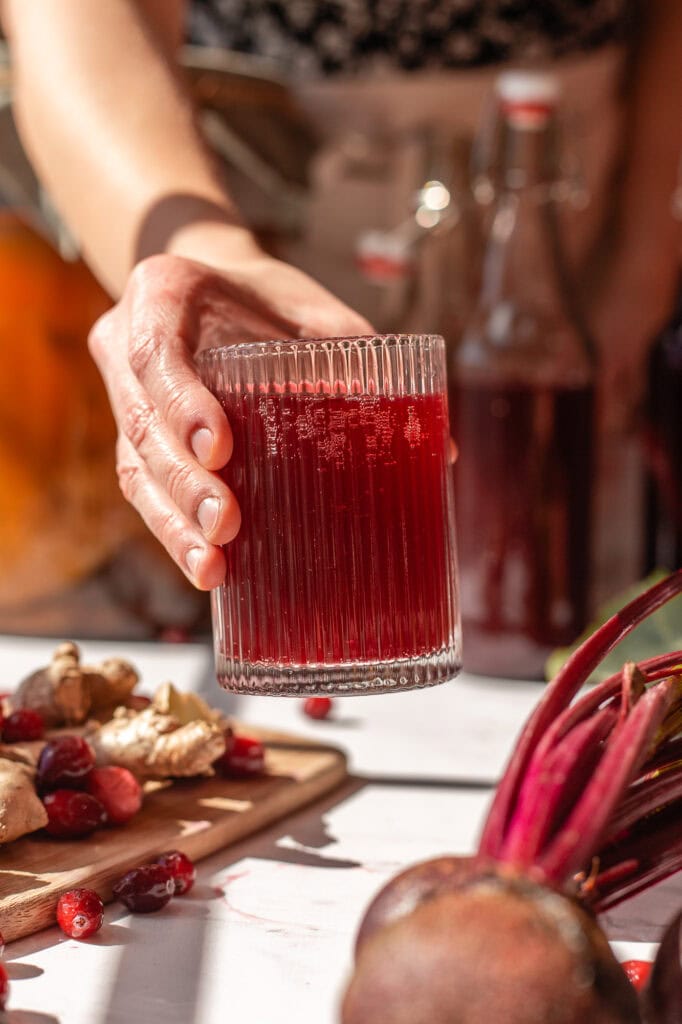











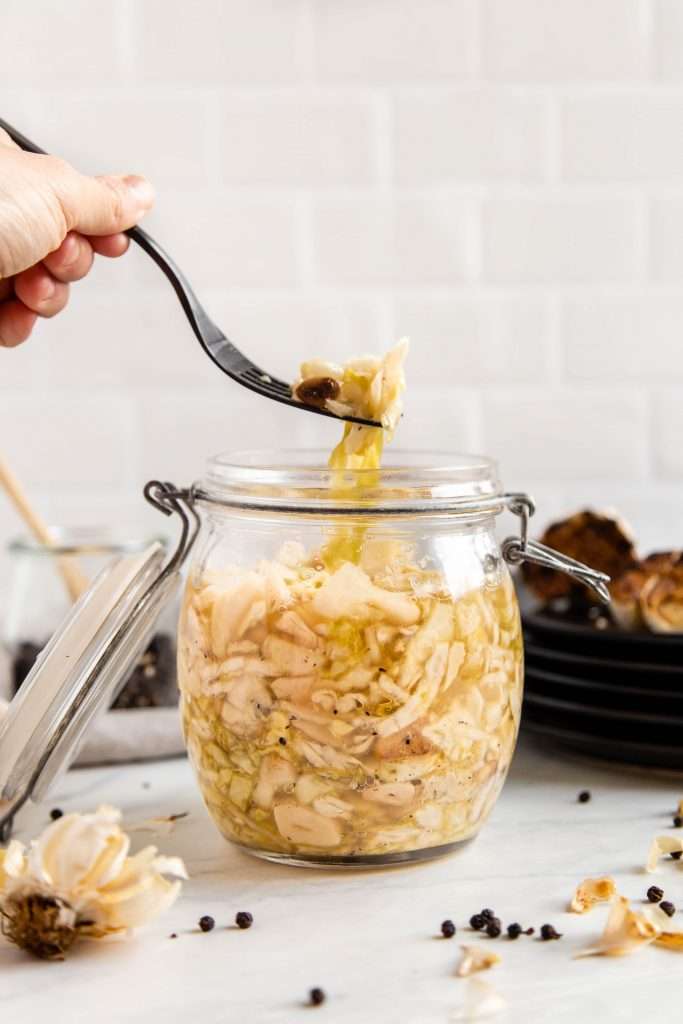


Does this recipe scale to a bigger batch? I’ve been doing 2 heads of cabbage in my 5 liter crock with 2% salt. All the recipes I’ve tried call for massaging the cabbage much longer and I find my sauerkraut always ends up mushy. Im excited to try your method with less massaging and adding water.
Apologies for the late reply on this comment! Just now seeing it. The recipe does scale up. This recipe makes about 0.45 liters, so just multiply the recipe amounts by 10 and you should have right around a 5 liter quantity! ?
How much carraway am I going to put?
Can I ask a question regarding water? Do you always need to add water with the salt and cabbage if using a bowl method or is this just for the jar method? I used a different recipe before which was just salt and cabbage and massaged/mixed which then created the salty brine but I didn’t feel there was a lot of liquid there for the cabbage to ferment in. It came out smelling and tasting okay just a little salty so I will use your calculation next time. Thanks
Adding water is not a requirement for a successful sauerkraut fermentation, but it helps keep batches consistent. Having water as part of our recipe also helps with consistency amongst all people who use our recipe. How old a cabbage is, what season it was grown in, and how long it’s been sitting in your fridge all influence how much brine can be created from using just salt and cabbage. So, adding water eliminates a lot of possible issues and unnecessary troubleshooting.
Thank you so much.
Than you for the information you provide on your website. Can I use red cabbage for this recipe & is the cabbage crunchy when fermented. If not can I add anything to keep it crunchy. Thank you in advance if you reply.
You’re welcome! you can absolutely use red cabbage. If you follow the recipe here, go easy and gentle on mixing the cabbage and salt, don’t pound it or mash it, it will stay crunchy! Since this recipe calls for some water, there’s no need to mash the cabbage to get the water out.
How do I compute for the amount of water needed?
The amount of water is listed in the recipe. If you want to learn my techniques for developing fermentation recipes you can visit our online school!
I don’t know what I messed up – I followed the recipe to a T (I was quite anal about the details) – made the recipe 4x in 4 separate jars and 3 out of the 4 have mold on day 13 – I have no idea what I did differently ….
Did you use a fermentation weight? What kind of jar and lid did you use? How did you clean your jars and equipment before you began?
I just made 2 double batches since I have 2 jars 34oz each. This is my first time fermenting anything…thank you for the info! You mention to ferment at 70-80 degrees. We keep our house between 64 and 68 degrees in the winter. I am assuming this will slow down the process. If that’s correct, how much slower should I expect it to be? In other words what is the timeline that applies to me, since it will be different than the one you provide?
Thank you so much! I save several other recipes and can’t wait to try them!
May I ask this question to remove any confusion. I see some recipes where they use hot water bath for their sauerkraut after the fermentation process. I believe so that they can store it on the shelf instead of the fridge. Will this destroy the probiotics after the hot water bath? ‘Thank you .
Yes, some people use canning methods to make the sauerkraut shelf-stable. This usually kills all the beneficial bacteria so fermentation will not continue at room temperature, but it depends on the temperature and canning method.
How many days are you supposed to burp the jar? I’m on day 6.
As long as it is bubbling, usually about 7 days.
Hi, first of all thank you so much for your amazing work and all the free resources and knowledge you give to us! I have a question regarding the lids you use. The plastic tough tops are very hard to get in Germany, so I was wondering what their benefit is exactly. Aren’t normal mason jar lids leak proof and airtight, too? Or why do you use the plastic ones during fermentation and the normal ones after? Thanks in advance for your help. Cheers, Patsi
Hi there! You are welcome.
The plastic lids do not rust, that’s the only benefit really; they last longer. They’re also easier to open. I use normal mason jar lids all the time. Sometimes I switch between lids, because I only have a few plastic ones, so I use those while the ferments are bubbly so my metal lids don’t rust. When the bubbling stops I’ll switch to a regular metal lid, so I can use the plastic one for a different ferment.
Since the lid is closed, is there risk of the jar bursting during fermentation?
No, you burp the jar daily during the bubbly phase of fermentation. There’s information about burping the jar in the body of this blog post, above the recipe card.
I am planning on making this recipe today hopefully! But was wondering if my water needs to be anything special?? Filtered? Distilled? Can I just use filtered tap water?
Filtered tap water works great!
I'[m at day 20 and I don’t see any mold, and it smells pretty good. But my brine has not been above the cabbage for a week or so now. I had a lot of brine during the bubbly phase but once the bubbles stopped it seems like there is not enough. I have every few days been opening it up and pressing down my weight to move the brine up , but within a few minutes the brine sinks down below my cabbage, about 0.5 inch. Is this okay? I am almost ready to taste test but didn’t want it to not be properly fermented. Thanks for all your help! This is my first time doing this
Yeah, that’s okay. It happens to mine in the later days of fermentation sometimes too. If it smells nice, and looks fine, you can taste test and refrigerate!
I made this and love it! Such a good recipe… it will be a staple in our fridge! One question I had, once you’ve moved it to the fridge… how long would you say it’s good and safe for? Do ferments tend to stay good for a while?
So glad you loved it! We’d appreciate it if you give the recipe 5 stars 🙂
it’s good in the fridge for a year or more! I generally eat it all before that point.
Loved this recipe! So easy to follow and turned out perfect!
I have a strange question, but how strong does this smell? How does it compare it canned sauerkraut? Does the whole fridge smell like it? My husband is particular about smells and I don’t want to make it and then not have him like it.
It can smell during the bubbly part of fermentation, but I don’t think it’s bad. I’ve been fermenting for over 10 years though, so I don’t really notice the smell.
I just tried this recipe for my first time, forgot
To burp daily, maybe only did it a couple of times. I’m on day 23 and I tested it and it didn’t taste good. Is that mean I let it go too long? Or do I need to keep letting it ferment?
Are you familiar with the taste of sauerkraut? “didn’t taste good” does not tell me enough about your experience. If you can elaborate more, I can help you determine what, if anything, went wrong.
Hi Kaitlynn, I have just made my first batch of sauerkraut and I can not get all of the caraway seeds to stay under the ferment weight. Do I need to be concerned about this?
Thank you!
It should be fine, mine do not all stay under. I just make sure the seeds don’t stick to the lid. When it is bubbling and you burp the jar just open it up and rinse the lid off if there are seeds stuck to it.
Thank you!
Hello, discovered your recipes today and have spent some time printing a # of them. I really appreciate your back ground as a micro biologist ! Since it is an anaerobic process promoting lactic acid why do you recommend removing the rubber seal from the jar ? Could you use what I would call a French jar with the spring loaded sealed jars ? I have occasional flare ups of Diverticulitis & store bought sauerkraut helps. Can’t wait to make my own , I think it would be much better. Thanks again for your expertise . Tom 🙂
hi there! I’m glad to hear you are enjoying the recipes. I recommend removing the seal from weck jars so that gas can escape from the jar without needing to burp it, and it won’t break. Yes, vegetable fermentation is an anaerobic process… within the brine. Everything submerged in the liquid is anaerobic. It doesn’t matter if a little air gets in the top of the jar as long as everything is submerged in the anaerobic brine with a fermentation weight.
First of all, LOVE your web sight – wonderful recipes! I’m quite a cook and read recipes for fun; your recipes are fantastic. I’ve made sauerkraut before to poor results. I like the measuring in gms – very accurate.
When I made sauerkraut via your recipe & it smelled wonderful but the liquid got below the level of the cabbage because it kept seeping out of my airlocks (https://www.amazon.com/dp/B075LRMRDQ?ref=ppx_yo2ov_dt_b_product_details&th=1). The top level of sauerkraut had what looked like black stuff on it so I sadly threw the batch out (tho again, it smelled GREAT).
My question is – should I try again using airlocks? If liquid seeps out, should I add more brine? If so, what would the water to salt measurement be?
So glad you are loving the website. I don’t suggest using airlock lids, they cause issues. I recommend using fermentation weights.
Hi Kathlene,
I have a question about the green sauerkraut recipe. The jar I am using may be larger than the standard (I looked at the Quatro Stagionie jar and it does not say how many ounces it is) but anyway, the 550 grams of cabbage only fills it 3/4 full. Therefore I want to add more cabbage. Say I need 750 grams of cabbage (instead of 550) to fill it up; how much more salt and water would I need? How is this calculated? Thank you!
multiply the total weight of cabbage and water added by 2.5%
Thanks, but how do I know how much more water to add (If I’m using more than 550 grams of cabbage).?
What do you mean by burp, please?
Open up the jar to let the gas out, and make sure the lid and rim of the jar are staying clean.
Hello Kaitlynn
I have made this sauerkraut based on your recipe several times, it always turned out super well! But, I just opened the last batch. Its day 29, smell is just like it should be, nothing off. Taste is also good. No marks of mold or anything bizzare- apart from the brine- that is slimy.
Why do you think it could happen? Could it be safe to eat?
Thanks a lot!
You have viscous brine! It’s perfectly safe and normal, especially common in the wintertime. The same microbes that make bubbles can make oligosaccharides when the temperature is just right and the cabbage is in season. Those compounds make the brine vicious (and they’re good for you!)
My first fermentation attempt. . .Successful- I grew up eating Saurkraut at the holidays and thought this would be fun to try. loved it! I added a little bit more caraway seeds. Made some for Thanksgiving and my family devoured it! So, I double up for Christmas and gave as gifts. I’m going to try the Kimchi recipe next! Since trying this recipe, I have made an initial go at making my own yogurt, pickled cucumbers, and now on to Kimchi! I love the guidance you give! Thank you so much!
Hello,
I’m making a large batch of Saurkraut in a ceramic crock. I weighed the cabbage and added 2.4% of that weight in salt. After 24 hours, there isn’t enough natural brine to cover the cabbage, so I plan to add more brine. I think that if I added, for instance, 100g of water with 2.4g of salt in it, that should still keep my salinity where I want it, correct?
correct
Since all of your recipes are in grams, is it possible to just multiply by 28.35 to get an appropriate amount of ounces or is using a scale what’s best?
Hello! You need to use a kitchen scale for my recipes. Even if you decide to use ounces, you need a kitchen scale to measure. You cannot convert mass units to ounce volume units.
I was wondering if I can use regular/course sea salt.. I believe mine is refined does that matter? thanks!
yeah, regular sea salt works great. Just make sure it doesn’t have anticaking agents in it.
Do you have any recipes for fermenting hot peppers? That would be awesome!
yes! Pepper Fermentation Recipe: Learn How to Ferment Any Type of Pepper
Simple, easy, and delicious!
This was my first ferment and it turned out great. I omitted the caraway but will use it next time. My only regret is that I didn’t start a new batch sooner as the original ferment will be gone before the the new is finished fermenting.
Thanks so much for the recipe! I tried this out for the first time last month, so I’m on day 18. For about a week now there’s been a white film that’s developed on the surface of the brine and on/around the weight. Could it be kahm yeast? If so, what should I do about it? The sauerkraut still smells ok. Thanks!
sounds like kahm. You can scoop it off and put the jar in the fridge.
I made this recipe and the result was better than expected. This sauerkraut is just delicious. I’m going to make my second round.
This is the best most consistent sauerkraut recipe I’ve found. It never fails! I’ve had many failed batches, but this one has never let me down. Highly recommend!
Love this! I’m glad you found consistency with my recipe! Thank you for leaving a review.
I used to purchase Cultured Guru fermentation products every week. Now I’m making my own using their recipes. This one was simple and straight forward and tastes delicious. Looking forward to branching out into some other variations this year.
I’m glad you transitioned to making sauerkraut at home! and that you enjoyed the recipe!
Love this recipe! I’ve made it several times. I had to leave it on the counter longer than normal since it’s winter and colder inside. The water level in my jar dropped below the top of the cabbage and it continued to sit out. It’s not moldy and seems fine. Do you think it’s ok to consume? I fold a whole cabbage leaf on top of the chopped cabbage and then put the weight on top of that, so the only thing exposed to air was the whole leaf which I throw away anyways.
If it is not moldy and smells fine, it’s good to eat! this happens to me in the winter sometimes too.
Can you use a fermentation lid for this?
I suggest using a regular rust proof plastic mason jar lid. I never use special fermentation lids. All the equipment I recommend is linked in the body of this blog post.
I’m so excited about this. All has gone well so far. I’m on day 18 and it smells alcohol-like. Is this normal?
Yep! Just let it keep fermenting. The fermentation that happens during the bubbly part gives off soapy/alcohol smells.
Hi! Mine has gone the full fermentation period and still has an alcohol like smell. Otherwise looks/tastes okay though in the bite I tried. Still good to eat?
oh yes, it’s still good. that smell is very common in the winter, and will go away if you let it ferment longer. It’s usually because it’s cold and winter cabbage has more sugars in it, so it takes longer to ferment.
I am at about day 10 of the process. The cabbage has a pleasant sour smell, but there is a white film on my weight. Is this a problem? Is it Kahm yeast?
Outstanding and easy to follow! I’m on my second batch.
I made this recipe weeks ago. It smells great but when burping the jar it never had much in the way of bubbles. I think perhaps the plastic lids are not as airtight as I thought but not sure. Any ideas?
bubbles only build up a lot if the lid is tight. If there were some bubbles in between the shredded cabbage, then that still counts as bubbles. It doesn’t need to explode out the jar.
Thank you so much for all the great content – I’m following your Account on Instagram for a while now and finally decided to try this recipe 🙂
I just started today around 1pm and now at 10pm the water above the glas-weight is brown already. Is this normal?
I read that it can come from oxidation? Should I put the rubber on the lid for less oxygen? I removed the rubber as you suggested and only closed the glass lid
I am unsure where the color comes from…
Thank you so much and kind regards
Natalie:)
did you add caraway seeds? may just be some color from that. Oxidation wouldn’t happen that fast.
Yes I added caraway seeds! Thanks 🙂
Also I am using a wire frame glass but left out the rubber gasket – do I still need to burp the glass? It seems like the gas is already getting out because I removed the rubber gasket…
Hi! I love this recipe and have made it several times. For this latest batch, I had amazing bubbles and it smelled great for the first few days, but around day 5-6 the brine got really cloudy and the bubbles have almost completely stopped. This hasn’t happened to me before. It seems too early and I’m concerned about the brine. I can’t tell from the smell if it’s bad or not. Should I toss or does this sound normal?
Hi! This is all normal and how it’s supposed to happen. (yay!) It’s supposed to get cloudy and the bubbles are supposed to increase, then decrease, then stop completely. As the bubbles stop, the cloudiness will settle as sediment in the bottom of the jar.
I have a white film on top of the water after 22 days, is this acceptable? I have a picture but no place to post it. Any help would be appreciated.
sounds like yeast. You can scoop it off and refrigerate. What kind of lid did you use and did you keep it clean throughout the process?
I forgot about my sauerkraut and did not burb the jars until 1x on day 6 No mold and they smell sweet/sour. The top is cloudy. Are they okay to eat? Is the cloudiness due to yeast?
My kraut has fermented for 3 weeks but is not as sour as usual and tastes more salty. It is very crunchy. Perhaps I used too much salt? I used the amount came for in the recipe but used canning salt instead of sea salt.
If I wanted to add carrots – what would be your recommended ratio with cabbage?